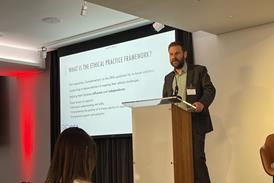Qualified one-way costs shifting cases are now beginning to come through. QOCS applies only to personal injury claims, and where there is no recoverable success fee or after-the-event insurance premium. So there is a long tail of pre-1 April 2013 cases. It is now clear that if there has ever been a recoverable additional liability, even if there no longer is, QOCS does not apply.
In Landau v The Big Bus Company, 31 October 2014, Senior Courts Costs Office, Master Haworth held that where there had been a recoverable additional liability in relation to the trial, and a second conditional fee agreement was entered into – without a recoverable additional liability – for the appeal, the claimant did not get the benefit of QOCS for the appeal.
As the pre-Legal Aid, Sentencing and Punishment of Offenders Act cases tail off, QOCS becomes ever more important. Few cases have been decided so far, as the existence of QOCS or otherwise is only determined at the end of the case (Civil Procedure Rule 44.14(2)), and only if the claimant has lost or failed to beat a part 36 offer. So the case needs to be post-LASPO and have gone to a contested hearing; the issue will not arise in settled matters.
The year of QOCS
So 2015 is the dreaded Year of the Sheep, when people in China avoid having babies as sheep are meek creatures raised for slaughter. It is also the Year of QOCS, which may be similarly problematic. The rules, barely a page of A4, at CPR 44.13 to 44.17, are fraught with difficulties. Practice Direction 12 – not part of the rules – is directly contradictory in some instances.
Understandably, defendants do not like QOCS, because, as Judge Michael Cook asked: ‘… under QOCS, might even the weakest case now have a nuisance value? Will this be a blackmailer’s charter?’
QOCS does not apply if there is fundamental dishonesty. In relation to a defendant’s costs on a claimant’s failure to beat a part 36 offer, or a complete loss, a costs order is enforceable against the claimant only to the extent of damages and interest – the ‘damages wipe out’ option. Obviously, if a case is lost completely, there are no damages and interest at all.
Insurers are bound to seek to enforce any unsatisfied costs order against parties other than the claimant, and the possibilities are surprisingly wide. Here, I do not consider the potential liability of third-party funders.
Rather, I look at the potential liability of solicitors and others in their capacity as the recipient of a financial benefit in the proceedings. Section 51(3) of the Senior Courts Act 1981 gives a court virtually unfettered power to make a costs order against a non-party:
‘(3) The court shall have full power to determine by whom and to what extent the costs are to be paid.’
In Excalibur [2014] EWHC 3436 (Comm), the High Court said ‘The discretion is very wide…’ (para 64).
It has famously been said that in relation to costs the only rule is that there are no rules. Not quite true. The key rule is CPR 44.16(2):
‘(2) Orders for costs made against the claimant may be enforced up to the full extent of such orders with the permission of the court, and to the extent that it considers just, where
(a) the proceedings include a claim which is made for the financial benefit of a person other than the claimant or a dependant within the meaning of section 1(3) of the Fatal Accidents Act 1976 (other than a claim in respect of the gratuitous provision of care, earnings paid by an employer or medical expenses); or
(b) a claim is made for the benefit of the claimant other than a claim to which this section applies.’
The first thing to note is that that provision clearly provides for costs orders to be made against the claimant as well as the financial beneficiary. So a claimant, as well as the financial beneficiary, loses QOCS protection.
CPR 44.16(3) then provides that an order may be made against that other person:
‘(3) Where paragraph (2)(a) applies, the court may, subject to rule 46.2, make an order for costs against a person, other than the claimant, for whose financial benefit the whole or part of the claim was made.’
Practice Direction 12.2 then specifically refers to credit hire claims as being a claim for the financial benefit of a person other than the claimant. That being the case, CPR 44.16(2) and (3) apply, meaning that, with the permission of the court, the order for costs against the claimant may be enforced up to its full extent against the claimant, or an order for costs may be made against the credit hire company.
But it is entirely unclear how the drafter of the practice direction has concluded that credit hire claims are different from any other type of special damages claim. That is most certainly not the attitude that the courts have taken. The courts have regarded credit hire claims as just another aspect of a claimant’s special damages claim. The claimant has had the benefit of the use of the car, and is liable to pay for it, and seeks those expenses from the defendant.
This was put beyond doubt by the Court of Appeal in Bee v Jenson [2007] EWCA Civ 923. The logic of that is that any special damages claim opens the beneficiary of the special damages up to a costs order and as we have seen, deprives the claimant of QOCS. I am reinforced in this view by the fact that CPR 44.16(2)(a) – set out above – specifically gives QOCS protection back to gratuitous providers of care, employers who pay earnings and the recipients of medical expenses.
By definition, any item of special damages is, in one sense, for the financial benefit of someone other than the claimant. On the face of it, any special damages claim other than for medical expenses, gratuitous provision of care and earnings paid by an employer, disqualifies a claimant and the recipient of special damages from QOCS.
What are medical expenses? Are care costs medical expenses? If so, why is the exclusion limited to ‘gratuitous’ provision of care? Why not exclude all care costs? What about adaptations to a house? It is hard to see how they could be classed as ‘medical expenses’. Likewise domestic assistance, child minding, home maintenance, decorating, gardening and chauffeuring, for example. The list goes on.
A successful defendant – in a personal injury case, typically an insurance company in reality – will get a full costs order; the issue is enforcement. By definition, the case will be at court, and so a defendant has nothing to lose by seeking in every such case to enforce the order against the claimant and/or the potential financial beneficiaries.
A solicitor bringing the case is also a potential financial beneficiary, and is potentially open to have costs awarded against them under CPR 44.16, as well as the general jurisdiction under section 51(3) of the Senior Courts Act.
As far as wasted costs orders are concerned, one of the grounds is that the other party has lost out because of the solicitor’s negligent advice to their own client. Thus the argument would run that the claim was weak – proven by the fact that it was lost, and that the defendant has incurred legal costs which, because of QOCS, it is unable to recover from the claimant, and therefore a wasted costs order should be made against the claimant’s solicitor.
That is a perfectly feasible argument which is bound to be raised very much more often now. In a pre-LASPO age where a defendant could not only enforce the costs, but actually had a party able to pay in the form of an ATE insurer, there was no point in a defendant seeking a wasted costs order. They are not easy to obtain, but the threat of them is likely to have a chilling effect on claimant lawyers, for obvious reasons.
What about a solicitor’s liability under CPR 16, as a financial beneficiary, where the hurdle will be very much lower than that of a wasted costs order? In Flatman and Germany v Weddall and Barchester Healthcare Ltd [2013] EWCA Civ 278, the Court of Appeal held that solicitors who help their clients by funding the cost of disbursements should not be liable for costs if the case fails, even if no ATE insurance is in place.
This was a pre-QOCS decision, but the appeal court recognised its importance in relation to QOCS, saying: ‘Defendants’ insurers can undermine the principle of QOCS (which will limit recovery of costs by insurers in failed personal injury actions) by pursuing the solicitors acting for the claimant who fails.’
But the Court of Appeal appeared to get a little confused between CPR 44.16 and section 51(3), as it said at paragraph 45: ‘… the legislation does visualise the possibility that a solicitor might fund disbursements and, in that event, it would not be right to conclude that such a solicitor was “the real party” or even “a real party” to the litigation.’
That may be true, but that is the section 51(3) test in relation to non-parties orders, included wasted costs orders. It is readily apparent that the test under CPR 44.16 is very different, and the hurdle very much lower. One could be a financial beneficiary of a claim under CPR 44.16 without ever coming near being ‘the real party’ or ‘a real party’.
So the decision in Flatman, although welcome, may be seen as of limited application in relation to the test under CPR 44.16. The danger is that solicitors will become over cautious about bringing anything other than the safest claims, and will also be too ready to accept a low part 36 offer. Will claimants’ solicitors prove 2015 indeed to be the Year of the Sheep?
Kerry Underwood is senior partner at Underwoods
- This article first appeared in the February issue of Gazette sister publication Litigation Funding, the essential guide to finance and costs. For subscription details, tel: 020 7841 5523.






























1 Reader's comment